
Pursuing innovative, non-invasive treatments for problematic foot ailments is never-ending for those who treat foot and ankle conditions. Plantar fasciitis is among the most prevalent of the many foot problems that patients seek treatment for. In the quest for promising solutions, shockwave therapy for feet has emerged as a regenerative powerhouse offering non-invasive treatment that provides new hope for patients plagued by pain and discomfort associated with plantar fasciitis.
Insights abound in this comprehensive guide and demonstrate the importance of Extracorporeal Shockwave Therapy (ESWT), the innovative modality revolutionizing medicine and patient care. This guide dives into shockwave therapy, its applications, clinical efficacy focusing on plantar fasciitis, the best devices, and more.
Increasingly, patients are seeking treatment approaches that are efficient, well tolerated, and non-invasive, with no need for downtime – and shockwave delivers that along with optimal patient outcomes. This compendium of information empowers medical professionals to approach plantar fasciitis treatment with renewed enthusiasm and certainty.
Common Plantar Fasciitis Treatment Protocols
Plantar fasciitis is a common and troubling foot condition that causes adult heel and arch pain. This condition is caused by inflammation of the plantar fascia, which connects the heel bone to the toes.
The condition can cause excruciating pain and be particularly debilitating as it makes walking difficult and standing for extended periods next to impossible. Patients report that the worst pain often occurs in the morning upon rising and stepping out of bed.
Upon diagnosis, treatment protocols are typically conservative and effective in nearly 90% of all cases and include:
- Physical therapy and stretching exercises
- Heel cups
- Orthotics and shoe modifications
- OTC non-steroidal anti-inflammatory drugs
- Extracorporeal Shockwave Therapy (ESWT)
Understanding ESWT for Plantar Fasciitis
Historically, foot and ankle specialists have relied on conservative approaches when addressing plantar fasciitis. Shockwave is a viable option for all podiatrists to consider as a primary approach. As a secondary approach to address plantar fasciitis cases, it’s utilized when a patient’s condition has been non-responsive to the conservative protocols noted above. Increasingly, though, shockwave therapy is being used as a first line and preferential treatment for troublesome plantar fasciitis mainly because it is so effective.
Research abounds on the efficacy of shockwave therapy for plantar fasciitis which has proven to be remarkably promising. Multiple studies confirm that plantar fasciitis patients experience reduced pain and improved functionality post-ESWT treatment.
What is ESWT?
Extracorporeal Shockwave Therapy is hailed as the most innovative approach to treating acute and chronic musculoskeletal pain and connective tissue disorders. Shockwave therapy, alternatively known as radial pressure wave (EPAT) and focused shockwave (ESWT), stands at the forefront of medical innovation.
Shockwave ignites the body’s natural capacity for healing, and biological effects are triggered, facilitating tissue regeneration.
Extracorporeal Shock Wave Therapy (ESWT) has gained widespread acclaim and recognition within the medical community, as a primary approach for plantar fasciitis. The efficacy of ESWT for plantar fasciitis has been clearly established in multiple clinical trials and meta-analyses.
How is ESWT used for Plantar Fasciitis?
Plantar Fasciitis treatment using ESWT is performed in a comfortable, in-office setting, and patients are not required to remove clothing (other than socks).
Here’s what the treatment looks like:
- Patients remain clothed and remove only their socks or stockings so that the treatment area is exposed.
- Patients are often positioned lying face down on the treatment table with legs supported by a pillow.
- Ultrasound gel is always applied to the affected heel area to optimize shockwave transmission.
- The handheld probe is carefully moved over the heel area, delivering compressed air pulses.
- The shockwaves penetrate the skin of the heel area, facilitating the stimulation of the regenerative healing process.
- In most cases, treatment duration is 7-10 minutes per affected area.
- On average, patients receive 3-6 treatments, one time per week.
- In addition to pain reduction, inflammation is drastically reduced.
Shockwave therapy for feet harnesses the power of targeted acoustic waves to ignite healing, quiet inflammatory responses, and remediate pain. This alternative healing method is a sought-after option that can eliminate the need for surgical intervention or corticosteroid injections.
ESWT Clinical Trial for Plantar Fasciitis
Researchers from Baskent University Medical School conducted a randomized, prospective, double-blind clinical trial on different energy levels of Extracorporeal Shockwave Therapy (ESWT) and the impact on clinical outcomes for participants treated for plantar fasciitis.
The study's intended purpose was to explore the efficacy of ESWT and compare its different energy levels and outcomes in the treatment of plantar fasciitis. Further, researchers assessed and compared plantar thickness and accompanying pressure distribution.
Explore the valuable insights within this study, which examines ESWT energy levels, by reading it in its entirety. The study titled “Comparison of Plantar Pressure Distribution, Ultrasonographic and Clinical Features Following the Application of Different Energy Levels of Extracorporeal Shockwave Therapy in Patients with Plantar Fasciitis: A Randomized, Prospective, Double-Blind Clinical Trial” was authored by Sukran Guzell, MD, Huma Boluk Selikci, MD, Hakan Suleyman Bal, MD and Bahtiyar Haberal, MD and published by The Journal of American Podiatric Medical Association, (JAPMA 112 4:e1-e26). Access the research document in its entirety to gain a thorough understanding of the study’s valuable insights
Materials and Methods of the Clinical Trial
In all, 51 participants involving 71 feet presented with heel pain and were diagnosed with plantar fasciitis between July and September of 2021. The diagnosis was made based on clinical presentations and evidence, including heel pain occurring in the first step upon rising or after rest and additional physical findings. An example of other symptomatology includes pain on palpation of the site (plantar fascia insertion to the heel bone).
Patient participant inclusion criteria were as follows:
- Age 18-85
- Experiencing heel pain
- Tenderness at the insertion site
- Non-response to conservative treatment (over a period of 3 months)
Specific criteria constituted exclusion from the study:
- Inflammatory rheumatic disease
- Presence of local dermatological legion or infection
- Peripheral circulation conditions
- Radiculopathy and polyneuropathy
- Congenital or acquired foot deformity
- Malignancy
- Cardiac pacemaker
- Metal implants at the site location
- Pregnancy
Energy Levels and Shockwave Therapy for Plantar Fasciitis
Study participants were randomly divided into three treatment groups reliant upon the sealed envelope method.
- Group 1 – 25 feet treated with low energy density (0.09 mJ/mm2)
- Group 2 – 25 feet treated with medium energy density (0.18 mJ/mm2)
- Group 3 – 21 feet treated with high energy (0.38 mJ/mm2)
Shockwave therapy for feet was applied using a circular motion over the insertion site of the plantar fascia (1000 shocks) and along the fascia for 1000 shocks, receiving three sessions each with 2000 shocks per session at one-week intervals.
All participants within three groups (treated with low, medium, or high energy) were treated using a STORZ Medical radial pressure wave device. During the clinical trial, no participant received additional treatment interventions such as physical therapy, injections, or anti-inflammatory medications.
Pre- and post-treatment participants were evaluated using the following assessments:
- VAS (visual analog scale) for pain
- FFI (Foot Function Index)
- Plantar thickness (measured with ultrasonography and plantar pressure distribution)
What are the Results of Using ESWT for Plantar Fasciitis?
Ultimately, among all participants in all three groups, post-treatment VAS and FFI were found to be statistically significantly lower than initial pretreatment values.
The study additionally concluded that neither of the levels (low, medium, high) of ESWT was found to be superior regarding pain, foot functions, fascia thickness, and pressure distributions while treating plantar fasciitis.
What are the Benefits of Offering ESWT for Plantar Fasciitis?
Demonstrating cost-effectiveness and sustained efficacy, shockwave therapy for plantar fasciitis is emerging as a clear frontrunner, far surpassing the success offered by conservative as well as invasive approaches. It should now be considered a cornerstone in managing cases of plantar fasciitis.
The benefits of shockwave for plantar fasciitis are numerous; consider them all:
- Significant pain reduction and taming of inflammation.
Numerous studies have proven shockwave therapy's efficacy and clinical benefits for plantar fasciitis. Reduction of debilitating symptoms spells relief for patients who were initially plagued by pain and limited movement.
- Eliminates or reduces the need for surgical intervention
Before the utilization of shockwave, patients who did not find relief in traditional treatments often had to opt for surgery. With the advent of shockwave, medical professionals can now provide patients with a breakthrough treatment offering optimal outcomes non-invasively. That’s a win-win for providers and patients alike.
- Accelerates healing and recovery timelines
This quickened healing response allows patients to get back on their feet (literally) and no longer be plagued by pain and associated nagging symptoms. They can return to activities they love much sooner than previously imagined.
- Improves patients' quality of life
The pain associated with plantar fasciitis is often chronic and debilitating. Post-shockwave treatment, patients are freed from pain and limitations to resume a healthy, productive life.
- Practice differentiation
Providers who feature cutting-edge solutions like shockwave therapy for feet define themselves as innovators offering best-in-class care to patients. Become the go-to source for treatment in your region and reap the rewards.
- Increasing practice revenue
Shockwave is like rocket fuel for your practice ROI. Think of the new stream of patients you’ll attract with this innovative medical technology.
Did you know shockwave therapy can also be used to support a variety of athletic injuries? Find out more in our guide to shockwave for treating athletes at your clinic.
What are the Patient Risks of Using ESWT for Plantar Fasciitis?
Shockwave therapy is considered remarkably safe overall. Despite that, following the procedure, certain patients may encounter temporary discomfort, redness, bruising, swelling, and numbness in the treated area. There exists a slight risk of Achilles tendon or plantar fascia rupture.
Additionally, in some instances, shockwave is contraindicated, including:
- Active infection
- Presence of malignant tumor
- Pregnancy
- Cardiac pacemakers
- Impaired coagulopathy
The Best Shockwave Devices for Foot and Ankle Specialists
As in the study mentioned herein, researchers selected a STORZ Medical radial pressure wave machine as STORZ Medical has long been considered the gold standard in shockwave technology. CuraMedix has enjoyed an enduring and esteemed partnership with STORZ Medical and offers the full suite of devices.
The following shockwave machines are best for treating foot and ankle issues like plantar fasciitis.
Ideally, physicians treating foot and ankle conditions, musculoskeletal and soft tissue disorders will use both radial pressure wave and focused shockwave machines powered by STORZ Medical. Below is a look at the entire suite of STORZ Medical shockwave devices offered by CuraMedix.
DUOLITH® SD1 Ultra Modular System
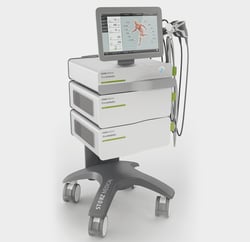 The DuoLith SD1 Modular System offers both radial pressure wave and focused shockwave along with vibration and vacuum therapies. With this superpowered device, physicians can address unrelenting plantar proximal fasciitis and an array of acute and chronic foot and ankle conditions.
The DuoLith SD1 Modular System offers both radial pressure wave and focused shockwave along with vibration and vacuum therapies. With this superpowered device, physicians can address unrelenting plantar proximal fasciitis and an array of acute and chronic foot and ankle conditions.
OrthoPulse Ultra 200
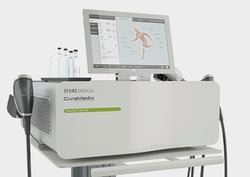 The OrthoPulse Ultra 200, also known as the D-ACTOR 200 Ultra and MASTERPULS® MP200, provides precision performance, functionality, and reliability for addressing both acute and chronic plantar fasciitis and other musculoskeletal or soft tissue tendinopathy and pain. Achilles tendinopathy, another common condition, benefits significantly from treatment with radial pressure waves.
The OrthoPulse Ultra 200, also known as the D-ACTOR 200 Ultra and MASTERPULS® MP200, provides precision performance, functionality, and reliability for addressing both acute and chronic plantar fasciitis and other musculoskeletal or soft tissue tendinopathy and pain. Achilles tendinopathy, another common condition, benefits significantly from treatment with radial pressure waves.
OrthoPulse Ultra 100
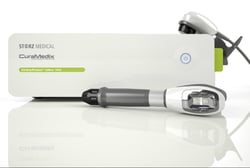 The OrthoPulse Ultra 100, otherwise known as the D-ACTOR 100 ULTRA and MASTERPULS® MP100, provides a blend of innovation and performance, delivering unparalleled clinical and economic value in tackling acute and chronic plantar fasciitis and other musculoskeletal. and soft tissue tendinopathies. It’s highly effective in treating foot and lower limb pain.
The OrthoPulse Ultra 100, otherwise known as the D-ACTOR 100 ULTRA and MASTERPULS® MP100, provides a blend of innovation and performance, delivering unparalleled clinical and economic value in tackling acute and chronic plantar fasciitis and other musculoskeletal. and soft tissue tendinopathies. It’s highly effective in treating foot and lower limb pain.
OrthoPulse Ultra 50
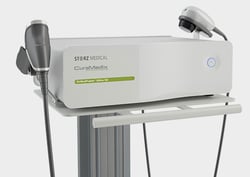 The OrthoPulse Ultra 50 is also known as the D-ACTOR 50 Ultra and MASTERPULS® MP50. It is a compact advanced radial pressure wave (EPAT) device used to treat acute and chronic plantar fasciitis, Achilles tendinopathy, and generalized foot pain and a host of musculoskeletal conditions
The OrthoPulse Ultra 50 is also known as the D-ACTOR 50 Ultra and MASTERPULS® MP50. It is a compact advanced radial pressure wave (EPAT) device used to treat acute and chronic plantar fasciitis, Achilles tendinopathy, and generalized foot pain and a host of musculoskeletal conditions
DUOLITH® SD1 T-TOP Ultra
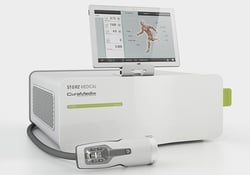 The DuoLith SD1 T-Top Ultra is for non-invasive treatment of various conditions. The SEPIA handpiece, with its ergonomic design, signifies a groundbreaking phase in focused shockwave technology (ESWT). This sleek design offers remarkable flexibility in patient treatment, making it the ideal solution for managing chronic and stubborn heel pain. Furthermore, doctors leverage ESWT to effectively address pain
The DuoLith SD1 T-Top Ultra is for non-invasive treatment of various conditions. The SEPIA handpiece, with its ergonomic design, signifies a groundbreaking phase in focused shockwave technology (ESWT). This sleek design offers remarkable flexibility in patient treatment, making it the ideal solution for managing chronic and stubborn heel pain. Furthermore, doctors leverage ESWT to effectively address pain
|
|
"ESWT has the highest level of evidence of anything we do for plantar fasciitis. When it comes to treating this issue, shockwave is the closest thing we have to a miracle cure.” |
|
|
"All of the doctors in our practice rely on EPAT to treat patients who suffer from Achilles tendonitis and plantar fasciitis. With EPAT, we have an 80-85% success rate in resolving their pain. Our patients actually look forward to their treatments because they know it's going to help them get better. I'm blown away by how well EPAT works and, honestly, wouldn't know how we would practice without it." |
Harness the Energy and Transforming Power of Shockwave Therapy for Plantar Fasciitis
Ready to lead the way in innovative treatment options in your practice? It’s sure to improve the trajectory of your practice and achieve optimal patient outcomes.
Patients suffering from acute or chronic plantar fasciitis and other troublesome musculoskeletal conditions are looking for solutions. And increasingly, they are seeking regenerative treatment modalities by name. Be the medical professional to provide best-in-class treatment options and open the doors of opportunity to a new stream of patients.
With shockwave and EMTT, you can now help patients get back to the activities they love sooner - with no surgery or anesthesia, no downtime, and no risk.
Consider how adding EPAT/ESWT/EMTT to your continuum of care would impact your practice and ROI. We’re here to answer any questions and are happy to connect you with one of our team experts — Contact us today!





